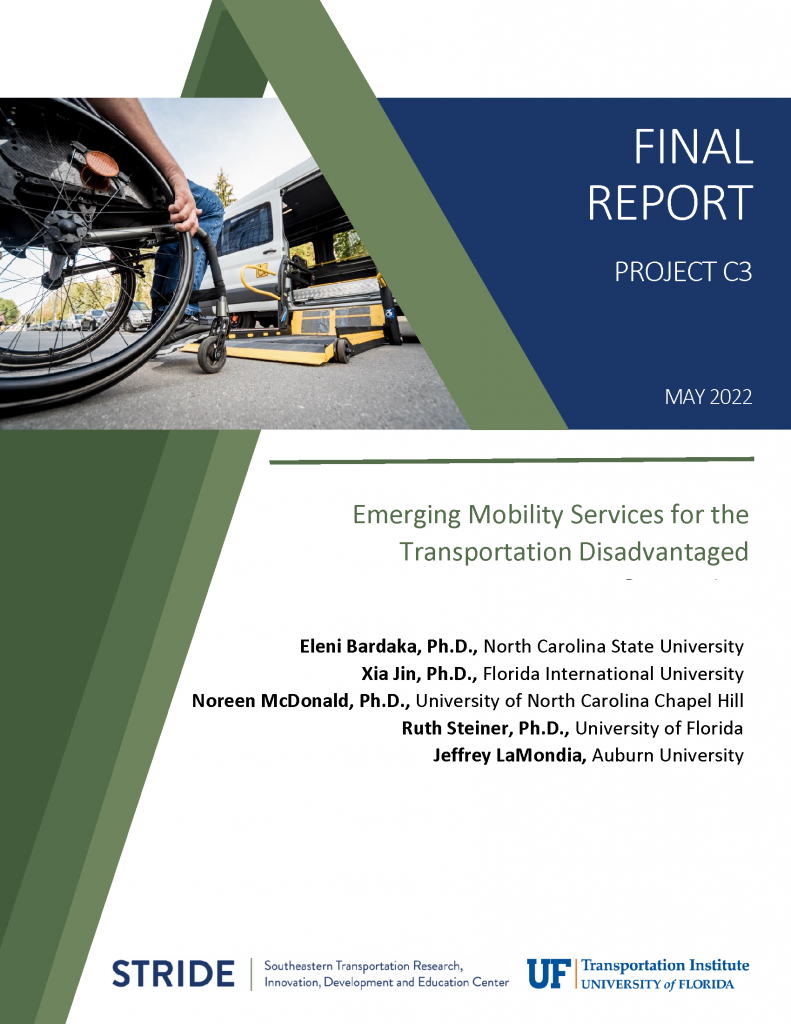Emerging Mobility Services for the Transportation Disadvantaged
Research Team
Eleni Bardaka, Ph.D., North Carolina State University
Xia Jin, Ph.D., Florida International University
Noreen McDonald, Ph.D., Univ. of North Carolina at Chapel Hill
Ruth Steiner, Ph.D., University of Florida
Jeffrey LaMondia, Ph.D., Auburn University
Abstract: This STRIDE project focuses on the travel characteristics of and use of emerging mobility systems by transportation disadvantaged populations. In thrust 1, the research team investigated how vehicle ownership and income interact with geographical location to affect trip characteristics, in addition to how travel behavior varied over time. Moreover, this thrust also explored the perception and use of active travel among households of different economic status in various spatial environments. In thrust 2, travel behavior and mobility preferences of older adults (age 65 and older) were examined. To evaluate the potentials of using shared mobility services to meet mobility needs of older adults, the research team further investigated the magnitude of cost-saving per month that would encourage travelers to switch from their current mode to ridesourcing services. In thrust 3, we used mobile device data to explore temporal patterns in visits to health care points of interest during 2020 and examined how these patterns were associated with block group-level sociodemographic and spatial characteristics in North Carolina. We reveal distinct inequities in visit patterns, which show block groups with higher population density and those with higher percentages of older adults, low-income individuals, racial and ethnic minorities, and people without household vehicles had lower rates of medical visits during the pandemic and experienced a slower recovery in visits after the state’s most restrictive lockdown period. In thrust 4, we developed and applied a tool to the Gainesville Regional Transit System (RTS) to understand the changes in transit accessibility for neighborhoods with concentrations of vulnerable populations (older adults, individuals with disabilities, and low-income households) throughout the COVID-19 pandemic (during, recovery and projected in five years) for five types of trips (work, medical, education, grocery and social). The analysis shows uneven changed during COVID-19 and a recovery for most types of trips. In thrust 5, the research team examined how MaaS is currently being utilized in rural communities as well as opportunities for MaaS to support existing travel patterns through comparisons to urban MaaS use. This work estimated logistic regression models to understand the regional, trip, and sociodemographic factors influencing current and future MaaS activity (i.e. mode choices and trip distances) in rural areas.
Technology Transfer Products
Product 1– Spatiotemporal Methodology to Compare Travel Characteristics for Low-Income and High-Income Populations
The methodology shows spatial and temporal variation in travel characteristics for low-income and carless populations in comparison to higher-income populations. Planners and transit agencies can use the methodology at the regional/local level to improve transit options for these households, particularly in suburban and rural areas.
Product 2 – Methodology to Examine Influencing Factors for Older Adults to Adopt Shared Mobility Services
The methodology examines the influencing factors for older adults to adopt shared mobility services. Planners, transit agencies, and social service agencies can use this information to design solutions that better address the mobility needs and challenges of the aging population. A description of the methodology will be published in the ASCE Journal of Transportation Engineering, Part A:
Systems.
Product 3 – Perspectives of Care Coordinators on Transportation Barriers to Health Care
Care coordinators working in North Carolina were interviewed about their perspectives on transportation barriers to health care. A summary of findings will be published in special issue of
Transportation Research Part A (Policy and Practice): Characterizing Health Pandemic Impacts on
Transportation Systems and the Demand for Mobility.
Product 4 – Set of Python Script Editors to Modify GTFS Data Based on Scenarios’ Needs
The four editors can be used for different purposes: 1. suspending specific transit routes; 2. decreasing the transit frequency of a route; 3. increasing the transit frequency of a route; and 4. changing the service span of a route. Public transit agencies can use the editors to match vulnerable populations with transit solutions that improve their accessibility to various destinations (work, groceries, education, social activities) and develop scenarios based on changes in routes.
